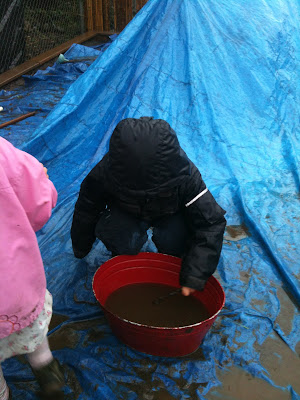Since the preschoolers first started at Tumbleweed, we have encouraged their love for all types of weather by being outside no matter what is happening in the sky.

Because of the preschoolers continuing time spent in all types of weather, they find as much joy in the rain as they do in the sunshine.
The preschoolers love the rain and are constantly working, exploring, and discovering as they experiment with the falling rain and the puddles left by the rain. Over the past couple of weeks, I have watched the preschoolers closely to see how many different ways they explore the rain.
Here are just a few observations of explorations and conversations highlighting why we love the rain:
We can explore puddles
We can make lakes and rivers
TS- "This is a lot. This is a river!"
We can gather water


We ask for help

TLC turned to SF and asked, "Can you fill up my container?" GS also asked SF, "Can you fill up my container?" SF replied, "Yeah."
We offer help
JH exclaims, "It's raining," as he walks over to TLC and GS. He asks, "Can I help?" He takes his container of water and pours it into TLC's container.
We can make soup
We can pour and mix
We can make observations about the rain
KC- "It's a downpour!"
We can swing as the raindrops touch our face
We can stretch and exercise
We can climb slick surfaces
We can build wet, slippery buildings
We can hunt for crocodiles
KC- "Crocodile water. There's a crocodile in there!"
MR- "Well they don't bite me."
JH- "Crocodiles are really scary."
We can measure and experiment with volume

We can balance on slick surfaces
We can explore how water falls through holes in the bottom of containers

SF- "TS, watch me!"
We can help life begin and provide nourishment for plants to prosper

Rain provides an outside environment of endless possibilities. The preschoolers pour, measure, mix, test volume and weight, share, imagine, create, water plants, and climb and explore wet textures the rain leaves behind. They are constantly discovering new ways to explore, experiment, and create imagined ideas with the rain puddles and wet surfaces.
We love the rain and what it provides.
As SF said last week as she noticed the newly fallen rain:
"Water... yay, yay, yay, yay!"
"Let
the rain kiss you. Let the rain beat upon your head with silver liquid
drops. Let the rain sing you a lullaby."
~Langston Hughes
For more outdoor ideas head over to:



















































